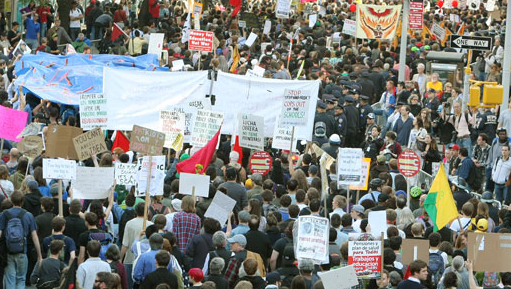
As a child, I remember celebrating the coming of Spring with our May Day festival. We learned dances, and practiced moving around the “May Pole” (which was actually out tether-ball pole!) with our ribbons in hands and our best Spring dresses swaying as we moved. This was a tradition practiced around the world, or at least throughout many Western nations as they celebrated the beauty of the new season. For this generation, May Day has come to hold a whole new meaning.
 With May 1 also being International Worker’s Day, many across the United States and around the world gather to protest the inequalities of our modern day. Some come as union members, bringing signs with their demands posted clearly, while others dress in black attire and masks, planning to cause destruction to those they see causing the inequalities.
With May 1 also being International Worker’s Day, many across the United States and around the world gather to protest the inequalities of our modern day. Some come as union members, bringing signs with their demands posted clearly, while others dress in black attire and masks, planning to cause destruction to those they see causing the inequalities.
Last year, in Seattle, Washington, 17 were arrested, many were injured, and much damage was done to cars and local businesses as one small faction of the larger protest movement started breaking car and store windows and urging others to cause mass destruction to the downtown area. Similar chaos erupted around the world in other major cities as worker unrest spread into the streets and large groups formed to share their anger at the way the world has changed for some, but not for all.
So how do you teach your students about this in your classroom? Do you stress their rights under the First Amendment in the United States or do you avoid the controversies that could follow from teaching your students to voice their anger at the world? Do you ask your students to evaluate the facts to form their own opinions about the big topics that pop into the news each and every year or do you teach about tolerance and understanding about all difference, including those involving equity and the opportunities for all mankind?
There is no set answer. It really depends on your teaching style, and your classroom climate. But one thing to consider… The youth are the ones leading these movements. How can we best prepare them to take on the challenges in our ever-changing world so that they can see the difference they demand without facing consequences for strategies not well thought out in the beginning!
Need some valuable reading resources on the May Day protests? Address CCSS with these informational texts:
- Local Seattle News on the May Day Protests of 2013
- CNN Video and Report on the May Day Protests of 2013
- NBC News on the May Day Protests of 2013
- Seattle Newspaper Article on City’s Preparation for May Day 2014
Need a class activity? How about having your students compare these modern day revolutions with the American Revolution? Here’s the rubric!
Happy Teaching!